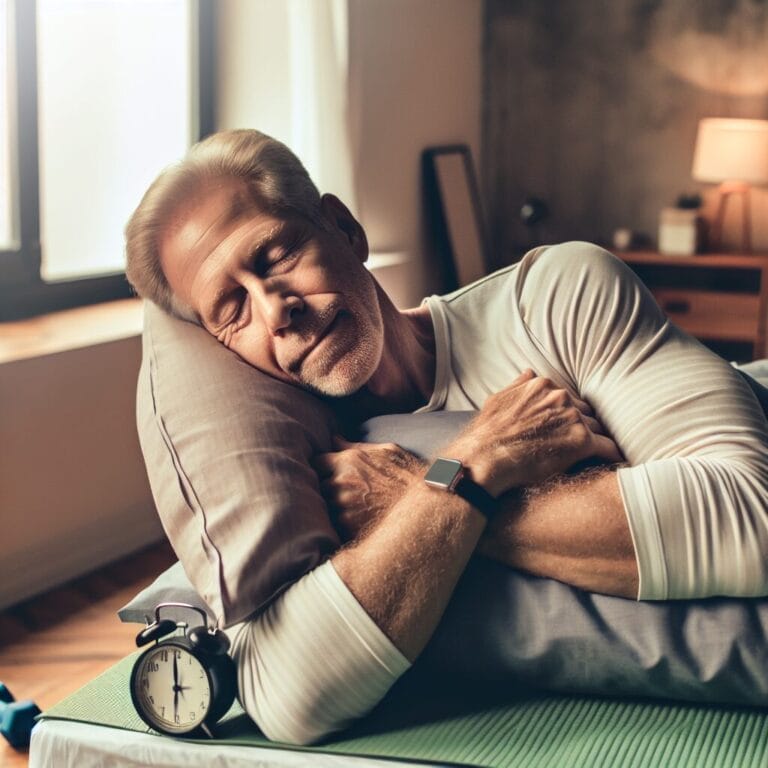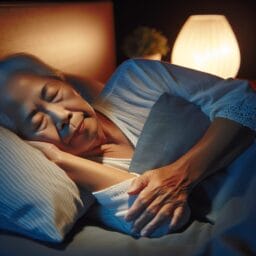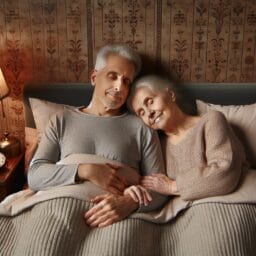
Get Restful Sleep: Top Tips for Older Adults with Sedentary Lifestyles
Table of Contents
- Introduction
- Understanding Sleep and Aging
- Creating a Sleep-Inducing Environment
- Diet and Nutrition
- Establishing a Restful Routine
- Medical Considerations
- Conclusion
- Frequently Asked Questions
Introduction
Did you know that as daylight dims and the stars twinkle, your body temperature slightly drops to signal it’s time to count some sheep? But for older adults, this little temperature tip-off might not be enough. Our seniors are often on a merry-go-round of sleep complaints, from trouble falling asleep fast to feeling sleepy all day long. Now, let’s sprinkle some fairy dust on those sheets and find magical ways to improve sleep quality for our wise wizards and gentle grandmothers!
First up, let’s talk about bedroom environment – it’s a biggie! To create a sleep sanctuary, the room should be cool (think about setting the bedroom temperature just right), dark (no sneaky slivers of light), and quiet (as hushed as a library). Lavender aromatherapy can add a calming scent-sation while deep breathing exercises before bed improved sleep quality by sending stress packing. And have you ever thought about sleeping position? Lying on your back with proper support can keep annoying neck and low back pains at bay.
Let’s not forget the magic wand of physical activity! A stroll in the late afternoon sunshine works like an enchantment for better zzz’s, as it helps sync one’s circadian rhythm with nature’s clock. Plus, engaging in regular activities can mean saying adios to irregular sleep patterns that often plague community-dwelling older adults.
What about siesta time? Naps are lovely but keeping them short and sweet ensures they won’t steal nighttime slumber. Stay awake during peak daytime hours and when night falls, so will you – right into dreamland.
Now imagine creating a pre-sleep ritual – something relaxing like meditation or listening to soft tunes – this could improve relaxation big time! And if counting sheep is getting old (or just isn’t cutting it), chatting with a healthcare provider may yield personalized strategies or gentle sleep aids without negative effects.
Bid farewell to chronic insomnia without relying solely on sleeping pills; instead, embrace these cozy habits that whisper ‘goodnight’ gently into older adults’ ears. With each small change comes the potential for giant leaps in achieving restorative deep sleep stages for all our cherished elders.
Understanding Sleep and Aging
As we age, our bodies undergo a symphony of changes, and sleep patterns are not exempt from this natural transformation. Older adults often experience alterations in the architecture of their sleep stages. The deep sleep phase shortens, causing more wakeful periods throughout the night. On top of that, growth hormone levels dip, impacting not only how soundly one sleeps but also the body’s ability to repair itself overnight.
Now flash forward to a typical afternoon—visualize golden rays flooding through the window as an older adult takes a moment to rest in their favorite chair. It might seem like the ideal setting for relaxation, but excessive sitting and limited activity can play a villainous role in disturbing sleep efficiency at night. Regular physical activity is instrumental for older people; it has been shown to significantly affect sleep quality by reducing the time it takes to fall asleep and increasing the duration of deep sleep stages.
Moreover, let’s navigate the often murky waters of common sleep disorders which stealthily creep into older adults’ lives. Conditions such as restless leg syndrome or sleep apnea wreak havoc on peaceful nights. Sleep disorders in community-dwelling older adults aren’t just about snoring or brief pauses in breathing; they’re deeply entwined with overall mental health and well-being.
With these challenges outlined, what can be done? Here’s where savvy lifestyle tweaks come into play:
– Bright light exposure during late afternoon hours helps reinforce the body’s circadian rhythm.
– Establishing consistent pre-sleep routines fosters an environment conducive to drifting off effortlessly.
– Considering low-back supportive mattresses and pillows aligns sleeping position with spinal health.
These intentional steps directly counteract poor sleep habits that may have settled in over time like unwelcome house guests. Also pivotal is regular dialogue with healthcare providers who can offer bespoke advice or recommend suitable sleep aids without adverse effects.
In essence, navigating aging-related shifts in slumber requires a treasure map of strategies—from adjusting bedroom environments to embracing exercises aligned with circadian rhythms—each tailored uniquely to improve relaxation before bedtime. As every individual’s journey toward overcoming sleep problems differs, weaving these various threads together offers a quilted promise for good night’s sleep across our tapestry of older adults found grappling with insomnia symptoms.

Creating a Sleep-Inducing Environment
Picture this: a haven of tranquility, where the hustle of the day melts away into a whisper. That’s not just dreamy talk; it’s what every older adult’s bedroom should feel like! To boost sleep quality, let’s zero in on making that sleep space oh-so-cozy. It starts with choosing a mattress and pillows that are like clouds – they’ve got to be just right, supporting the body without feeling like a bed of rocks. Then there’s light – or rather the lack of it! Using blackout curtains can keep out unwanted glares, so streetlights or moonbeams won’t disturb those precious winks.
Now, don’t get me started on gadgets and their pesky blue light! They’re tricksters, telling our brains it’s still go-time when we should be winding down. So here’s a nifty trick – switch off those screens an hour before bed, maybe swap them for a book or some mellow tunes instead. Speaking of temperature (because who can sleep when it’s as hot as a desert?), setting that thermostat to a cool 60-67 degrees Fahrenheit makes your body go “Ahh” and nudges you toward nodding off faster.
Creating this peaceful nook also means being smart about sounds. White noise machines? A big thumbs up! They drown out those jarring night noises that can jerk us awake. And if city life is too loud, consider earplugs for silent nights all year round.
Let’s chat about another secret ingredient to good night’s sleep – routine! Keeping to regular sleep and wake times sets an internal clock that loves predictability. Even better, sprinkle in some relaxation techniques like gentle stretching or imagining you’re floating on calm waters; now that’s serenity served on a silver platter!
Remember (but hey, not too much), snooze troubles don’t have to stick around like gum on a shoe—there are ways to shoo them away. From zapping those zany late-night TV shows to cozying up the room temperature, small tweaks can make waves in improving sleep time joyrides for our older folks’ slumber parties.
So whether it’s overhauling that bedroom atmosphere with snuggle-worthy bedding or dodging blue-light booby traps before bedtime—a treasure trove of simple steps awaits to escort older adults back into dreamland each evening without fail. Let’s champion their journey towards reclaiming the restful nights they deserve; after all, everyone should have access to sweet dreams and even sweeter mornings!
Diet and Nutrition
Hey, did you know chowing down on the right grub can send you snoozing like a baby? That’s right, what older adults nosh on can be a game-changer for their night-time winks. Let’s dish out some sleep-friendly eats! Think sleepy snacks like bananas or a spoonful of honey—these goodies are packed with stuff that tells your brain it’s lights out. And who can forget the classic warm milk trick? It’s not just old wives’ tales; milk has tryptophan, which helps your body make the sleep-a-lot hormone melatonin.
Now, before you go raiding the fridge, let’s hit pause on those midnight munchies that wreak havoc on your shut-eye. Caffeine and chocolate might seem like sweet pals during daytime doldrums but come bedtime, they’re party crashers turning good night’s sleep into an all-nighter. Same goes for spicy tacos or a big ol’ pepperoni pizza close to snooze o’clock; they’re no friends to your ZZZs.
Older folks gotta stay sharp about hydration too—it’s key for keeping cells in tip-top shape and at kicking away tiredness during day times so that when night falls, they’re ready for some serious pillow time. But hold up, don’t guzzle gallons right before bed unless you fancy moonlit strolls to the bathroom!
Let’s tie this snack chat up with a bow: Older adults should nuzzle up to foods and drinks that are more peacekeeper than party starter when it comes to bedtime rituals. Keep dinner lighter and earlier if possible, dodge those devious stimulants after sundown, and hey presto—you’ve set yourself up for a dreamy journey to Slumberville without stopovers at toss-and-turn junction.
So grab those mugs of chamomile tea and toast with almond butter—because when older peeps eat smart before hitting the hay, they’re paving the way for top-notch zzz’s. Sweet dreams are made of these tasty tricks!
| Food & Drink | Benefit | Best Time to Consume | Notes |
|---|---|---|---|
| Bananas | Rich in magnesium and potassium, promotes relaxation | Evening snack | Helps signal the brain that it’s bedtime |
| Honey | Contains natural sugars that can raise insulin and allow tryptophan to enter the brain more easily | Before bedtime | A small spoonful is sufficient |
| Warm milk | Contains tryptophan which aids in melatonin production | Before bedtime | Part of the bedtime ritual for many |
| Caffeine | Stimulant that can disrupt sleep | Avoid after afternoon | Includes coffee, tea, and some soft drinks |
| Chocolate | Contains caffeine and sugar that can interfere with sleep | Avoid in the evening | Dark chocolate has higher caffeine content |
| Spicy foods | Can cause discomfort and indigestion | Avoid close to bedtime | May lead to heartburn which disrupts sleep |
| Heavy meals (e.g., pepperoni pizza) | Can lead to discomfort and restlessness | Dinner should be lighter and earlier | Consuming 2-3 hours before bed allows for digestion |
| Hydration | Essential for overall health, avoiding tiredness | Throughout the day, but limit before bedtime | Prevents frequent bathroom trips during the night |
| Chamomile tea | Herbal tea that promotes relaxation and sleepiness | Before bedtime | Free of caffeine, can be part of a bedtime routine |
| Almond butter on toast | Provides a good mix of protein and healthy fats | Evening snack | Can help stabilize blood sugar levels overnight |
Establishing a Restful Routine
Did you ever think that a chit-chat with old friends could be a secret ingredient to dreamland? That’s right! Maintaining an active social life isn’t just about fun—it plays a snooze-worthy role, too! See, for older adults, gabbing away with pals or joining in on group activities can ease the stress and loneliness that often mess with sleep. It’s like this: when the heart is full of joy and the mind is clear from worries, falling asleep becomes a walk in the park.
Now here’s a nifty nugget: sticking to a regular bedtime schedule isn’t just for kids. For older folks looking to level up their sleep game, having set times for hitting the sack and waking up can work wonders. This sort of timekeeping tunes the body’s internal clock—the circadian rhythm—to get those eyelids drooping right on cue every night. And when it’s time to crawl out of bed each morning? They’ll wake up raring to go after a good night’s sleep.
But wait—there’s more magic to sprinkle on nighttime routines! How about weaving some relaxation techniques into that pre-bed hour? Meditation is a real gem; it helps smooth out any crinkles of worry or pain that might keep someone counting stars instead of catching Zs. Deep breathing exercises are another hit; they’re like lullabies for the lungs, setting up older women and men alike for deeper slumber without needing sleeping pills.
And let’s not overlook light physical activity—no need for marathons, though. A stroll around the block or gentle yoga can fire up those feel-good hormones while taking care not to amp up energy right before bed. This kind of move-and-groove does double duty: it tires out the body just enough so that when heads hit pillows, sleep sweeps them off their feet!
So there you have it: from cultivating consistency in sleep schedules to indulging in tranquil pastimes before bed—each step glides seamlessly towards sounder shut-eye. As community-dwelling older adults embrace these tips, they stand tall against sleep complaints and experience fewer restless nights—an absolute win-win in our book!

Medical Considerations
Hey there! Did you know that sometimes, the trick to a night full of sweet dreams might just be a chat with your doctor? You see, for older folks, if sheep counting and lavender spritzes don’t do the trick, it might be time to ring up their healthcare provider. These savvy pros can peel back the layers of those pesky sleep problems and shine a flashlight on what’s keeping them from dreamland. From ironing out kinks in their bedtime routine to maybe switching up meds that are sneaky sleep-stealers, doctors have the roadmap to Slumberville.
Speaking of meds – whoa boy, they can be like that one loud party guest when all you want is some peace and quiet. Certain prescriptions older people take can throw body clocks outta whack faster than a hiccup! That includes some medicines for blood pressure or even allergy pills. The magic lies in finding that sweet spot where medications help without tossing sleep quality out the window. And hey, let’s not forget about those over-the-counter sleep aids; they seem helpful but can sometimes leave older adults feeling groggy or drowsy when the rooster crows.
But hang onto your hats because there’s a whole other world of snooze-boosting secrets – think alternative therapies and natural supplements! Melatonin supplements, for instance, are like sprinkling fairy dust on eyelids; they’re well-known for helping folks fall asleep faster without any prescription hassle. Herbal remedies like chamomile tea or valerian root can also be superstars at sending you off to the land of Nod.
And check this out: from acupuncture pinpoints to yoga stretches – these holistic heroes could offer an express ticket to better Zs too! They often come without any pesky side effects that medications might invite to the party.
So remember (just this once), if twilight brings more tossing than tranquility, consider looping in a healthcare professional and exploring all avenues—from adjustments in medicine cabinets to herbal brews—because finding joy in jammies and saying goodnight shouldn’t be harder than climbing a pillow mountain!
Conclusion
Did you know that the moon’s gentle glow can affect how well our cherished elders doze off at night? It turns out, the lunar cycle might influence sleep patterns! While we’ve covered a lot about creating a dark, cool sleep environment, it’s time to talk about natural light. Exposing older adults to natural daylight, especially in the early morning, can help regulate their body clocks and improve sleep quality at night. And when evening rolls around, reducing exposure to bright lights helps signal to the brain that it’s nearly bedtime. This nifty trick supports their circadian rhythm—Mother Nature’s very own way of tucking them in. With these insights, older folks can work with their daily rhythms instead of against them, tackling sleep complaints with something as simple as sunshine and shadows! So let’s encourage our wise elders to soak up some morning rays for nighttime bliss and chase away those sleep disturbances for good.



